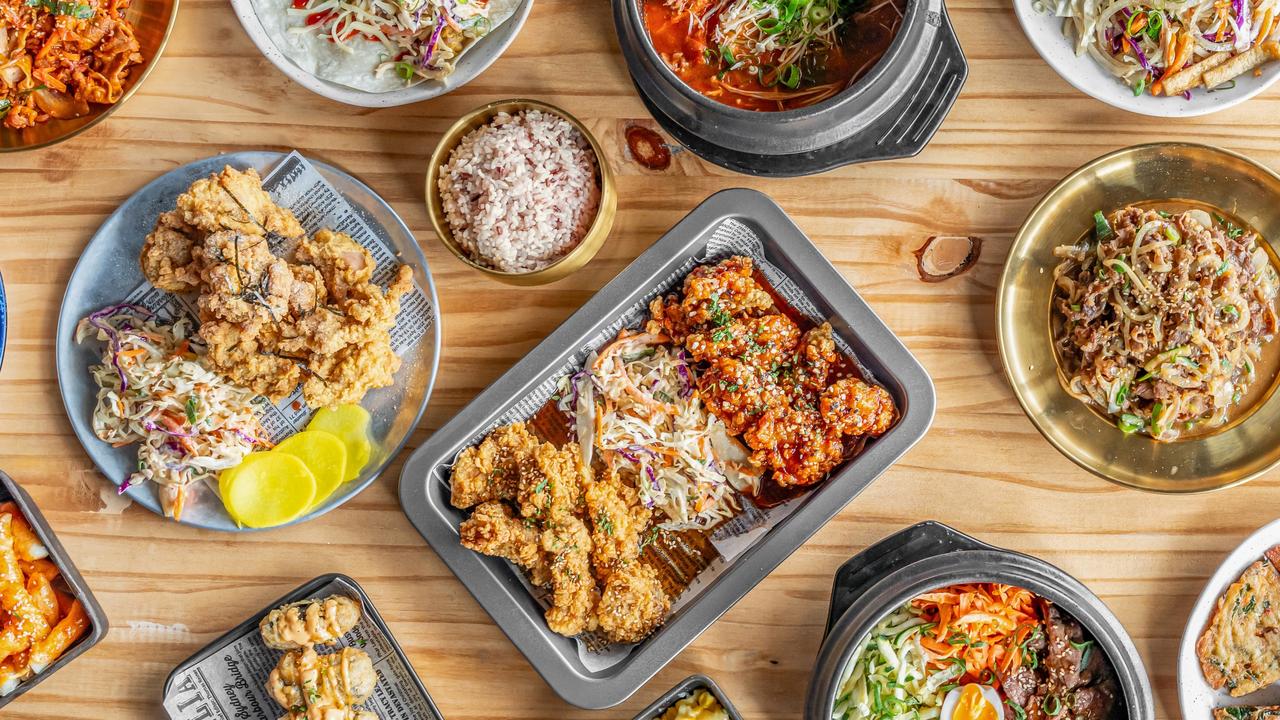TasWeekend: Behind Hobart’s cafe revolution
MANY of us struggle to start the day without a caffeine kickstart and any old coffee will not do.

Food and Wine
Don't miss out on the headlines from Food and Wine. Followed categories will be added to My News.
ON a rainy morning in central Hobart it seems every second person hurrying to work is carrying a takeaway coffee.
Some juggle their cardboard cup in one hand and an umbrella in the other, slurping milky foam as it escapes from the spout. Others balance two or three in a cardboard tray, ferrying lattes and long blacks to their colleagues in the office.
Market research company IBIS World last month put the value of Australia’s cafe and coffee shop industry at $4.3 billion a year nationally and about $86 million in Tasmania, although this seems modest given the high ratio of cafes per head of population in Hobart.
A queue is forming inside the exposed-brick hipness of Pilgrim Coffee on Argyle St.
The paramedics, suited office workers and hirsute 20-somethings all appear to know the drill. No convoluted coffee menu here.
“White” means traditional cappuccino (similar to a at white) and “black” means espresso.
Sure, you can request decaf or ristretto. But Pilgrim owner Will Priestley says the beans taste best when made traditionally.
Those in the know might ask for filtered, which has been all the rage in Melbourne and Sydney for a while and is catching on here (not to be mistaken with the American diner version of filtered coffee, this is high-quality, hand-poured stuff).
Priestley is coy about just how many takeaways his team pumps out each morning but it sure looks like a well-oiled money-making machine.
The ordering system is efficient, the barista is deft and the customers seem more than happy to wait a few minutes in the warmth.
A group of trainee doctors from across the road at the Royal fills a large table by the window.
A policeman pops in for his caffeine fix while most of his colleagues settle for a cup from coffee chain Hudsons directly across from police headquarters on Liverpool St.
“It’s a bit further from my work than other cafes but I like it better and the coffee’s the best around,” says human resources executive Mat Johnston as he waits for his order (“a white”).
“The staff are really nice, everyone knows your name and I know their names.”
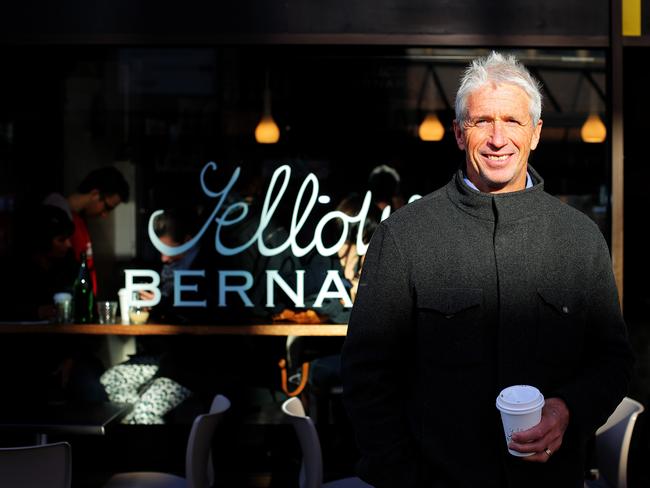
In the afternoon, when the weather has cleared, customers waiting outside Yellow Bernard on Collins St also get a warm fuzzy feeling when the baristas greet them by name.
“They know our names because we’ve been coming here for about four years,” office worker Julia Smith says as she waits with a colleague for their skinny lattes.
“It’s nice to have a break and get out and have a chat to each other about not work.”
IBIS World estimates Australians are spending more than $41million a week on takeaways and sit-down coffees, or about $850 a person each year.
Corporate lawyer Guy Abel has three coffees a day, usually opting for a large flat white from Yellow Bernard.
“I spend my $12 a day knowing that every time I get value for money,” Abel says. “It gives me a break from the office and I generally see someone I know and these guys [Yellow Bernard staff ] are great, they know everyone’s name.”
Hobart’s coffee scene has changed dramatically since 2006 when the stoush between Battery Point residents and coffee roasters Carlos and Nikki Kindred made headlines around Australia.
The founders of Oomph! Tasmanian Gourmet Coffee eventually won council approval to roast coffee in their former Hamden Rd site despite neighbours’ complaints about the smell, but they ended up moving out anyway, and these days roast award-winning coffee in Geelong, Victoria.
Back then few coffee drinkers thought much about where their coffee was roasted or even where it came from, beyond perhaps a country of origin.
With 12 years experience Dane Kinesevic is a veritable veteran of what is a relatively young industry in Tasmania.
Espresso coffee has been around since the 1950s in Australia and coffee houses date back to the temperance movement of the 19th century.
But specialty coffee – the science and art of sourcing, roasting, grinding and extracting the best (and most ethically grown) seasonal varieties – is something much newer.
Having started at his family’s Island Espresso in Elizabeth St, Kinesevic now runs the state’s biggest coffee roasting business, Zimmah, from a warehouse in Murray St.
“When I started three years ago we were doing 100kg a week and now we’re roasting a tonne of coffee a week,” Kinesevic says.
“With new businesses coming on line in the next six months we’ll be doing another 300kg on top of that.”
The days of Tasmanian cafes serving stale coffee from Italy are coming to an end, Kinesevic says.
“The public will no longer tolerate crap coffee,” he says.
“Kudos to the good Tassie roasters because we’re kicking the mainland companies out. The big companies are dropping like flies.
“I never thought Hobart would be where it is now, to be honest.
“A lot of the small cafes are doing 15kg [of coffee beans] a week, and you get about 70 coffees a kilo so at $4.50 that would be close to $5000 turnover. Some are doing 30kg a week.”
He names Salt cafe at Moonah as one of his star performing clients. Since taking on Zimmah’s advice and product, coffee sales have more than doubled, Kinesevic says.
“Salt in Moonah was doing 17kg a week, now it’s doing 35kg to 40kg a week,” he says.
It was a flat white at Villino in Hobart’s Criterion St that sowed the seed for this article.
Delivered without fanfare along with a small glass of water, this flattie was a work of art.
The creamy foam on top (just the right amount) had been poured to create a perfect image of a swan. Enough to make an otherwise ho-hum day memorable.
“That would have been Andy,” Villino owner Richard Schramm says later when asked about the creator of this masterpiece.
It turns out Villino’s head barista Andy Nairn was last year’s Tasmanian Latte Art champion, representing the state in the Australian Specialty Coffee Association’s national competition in Melbourne.
Schramm, a former IT consultant, says so-called “latte art” is no longer a novelty but almost par for the course.
“Latte art was relatively new when we opened eight years ago and now it’s the bare minimum.”
Schramm is a walking encyclopaedia of coffee. He lives and breathes the stuff.
With his tiny cafe and its hole-in-the-wall offshoot, Ecru, a few shops down, Schramm is trying to show his customers just how complex and rewarding coffee can be.
On a shelf along one of Villino’s walls sits what looks like a high school chemistry set with a series of glass beakers.
Over the course of eight hours, at the rate of about one drip per second, water is dropped onto the ground coffee.
This “cold drip” is served in takeaway bottles or in the cafe over ice, always black.
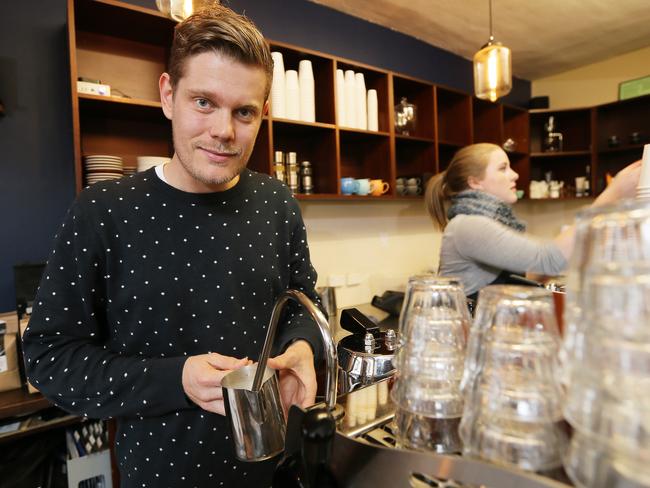
“It pulls the coffee out without the application of heat so it eliminates that bitterness and there’s a little bit more sweetness and more depth of flavour,” Schramm explains.
He proffers a sample that, according to the label, is an Ethiopian single-origin variety tasting of “rosewater, plum and dark chocolate”.
Resembling a wine or delicate liqueur the taste and feel is so unlike an espresso it is easy to see why Schramm wants to open his customers’ eyes to coffee’s greater potential.
“Some customers still just want to come in and have their coffee with no fuss but others come in craving that knowledge,” Schramm says.
“They’re brewing at home and they want to know as much as they can. That makes us really happy.”
Across town at Pilgrim, with a cup of super-premium filtered black coffee before him, Priestley discusses the latest advances in coffee science.
Like Villino, Pilgrim’s beans are weighed for each shot of coffee and refractometers are used to measure the amount of solids in each cup.
Their espresso machines have multiple handles, so different varieties can be poured at the perfect temperature and pressure.
“Red wine is the most comparable beverage to coffee except coffee is a much more volatile product,” Priestley says.
“Cup shape changes the way a coffee tastes and even coffee coming into contact with a different metal spoon will change the flavour of it.”
Like Schramm, Priestley is keen to educate his customers, although he admits his attempts are not always appreciated.
A recent sample of $100 per kg beans from Costa Rica, which Priestley was so keen to showcase he only charged the regular espresso price, went down like a lead balloon.
“People didn’t like it because it was too fruity, so I took a big hit,” he says. “I could easily make my coffee a lot more consumer-friendly but I like to try to taste which processing method it’s been through, which country it’s from and which varietal it is.”
‘The public will no longer tolerate crap coffee, kudos to the good Tassie roasters.’ – Dane Kinesevic
Priestley, a three-time Tasmanian Barista Champion, enjoys an almost star-like status in ustralia’s coffee industry, consulting to the big coffee chains and Pura Milk.
In 2010, he was Australian Latte Art champion and came runner up in the World Latte Art Championships in London.
When he started his career at Hudsons in Hobart after chucking in an agricultural science degree, Priestley’s dabbling in latte art annoyed his bosses to such an extent he was eventually shown the door.
“I can understand in hindsight that they wanted a uniform product across all their stores,” he says. “But after I came runner up at the World Championships Hudsons hired me to train their staff in latte art.”
Priestley learnt the ropes from Kinesevic at Island Espresso before moving to Melbourne, where he and four fellow baristas at Cafenatics in Docklands made more than 1100 coffees before 11am each morning.
He returned to Hobart to open Pilgrim in 2011 after roping in a bunch of friends to transform the space on a shoestring budget.
“I bought out a second-hand shop for $50,000 to get the lease and everyone thought I was crazy,” he says.
“But it’s across from the hospital, close to all the emergency services, around the corner from the police station and next door to Woolworths. In Melbourne any one of those would be reason enough to open a cafe.”
Coffee instructor Lauren Johnston, from Launceston’s Stillwater restaurant, says TasTAFE’s Barista Basics course is the one short course always guaranteed to sell out.
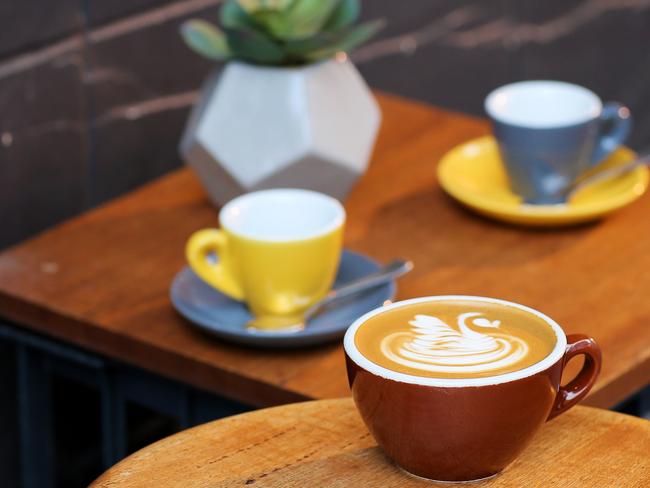
Held regularly throughout the year at Drysdale’s Hobart, Launceston and Devonport campuses, the two-day course promises to “lay a solid foundation for espresso coffee brilliance”.
“It’s the one commercial course that’s always full, there’s lots of interest from all types of demographics,” Johnston says.
“Generally it’s people with a personal interest, they’ve got a coffee machine or they’re thinking of getting one or they’re looking to get another skill to give them another opportunity for employment.
“People are changing the way they drink coffee, they don’t want to drink instant coffee at home anymore.”
The IBIS World report found Australia’s cafe and coffee shop industry is comparatively resistant to economic downturns with consumers of all income levels considering the beverage “an affordable luxury”.
“Consumers in the lowest income quintile are more likely to cut spending in the competing restaurants industry rather than forgo a cup of coffee,” the report said.
The report predicts continued dominance by small independent operators over big chains as customers seek “quality over quantity”.
Launceston coffee roaster Stuart Grant from Ritual Coffee says the trend is transforming the city’s coffee scene and even lifting standards in regional towns.
“Five years ago we struggled to find a cafe to recommend to visitors to Launceston and now there are at least five to 10 that I would happily recommend to fellow coffee aficionados,” Grant says.
Even pubs are jumping on board.
Tasmanian Hospitality Association general manager Steve Old says good coffee is becoming “almost as important as providing cold beer” in many venues.
“The days of caterer’s blend served up in a polystyrene cup with an ice-cream stick for a stirrer are pretty much a thing of the past and being able to do a good coffee is something venues take seriously,” Old says.
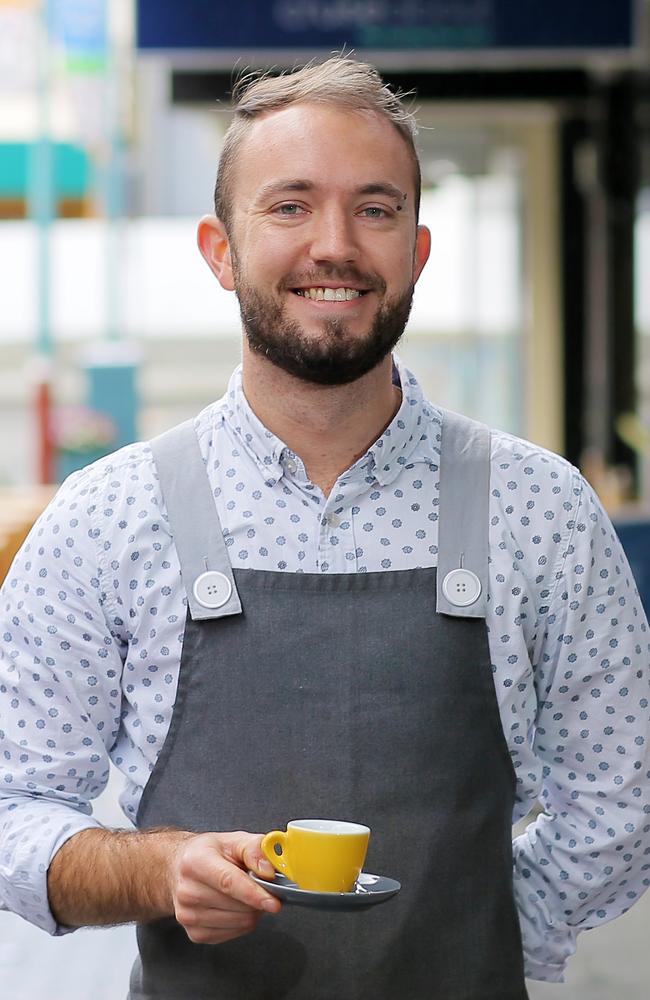
The question has to be asked, how is all this caffeine affecting our health?
Menzies Institute for Medical Research director Tom Marwick, who drinks three to four coffees a day, says much of the research is contradictory but on the whole there is little need for concern.
A meta-analysis of 59 studies in 2011 linked regular coffee consumption with a 10 per cent cancer risk reduction while another summary of 36 studies last year linked moderate coffee intake with reduced risk of heart disease and stroke.
That sounds like good news, but there is a catch, Marwick says.
“I think it’s what goes with the coffee that’s a risk,” he says.
“Both milk and sugar are a source of calories and there generally seem to be too many of those around.”
Kinesevic says he is asked almost daily “How can another coffee shop be opening up in Hobart, how can Hobart sustain this?”.
“For every one that opens, one will close,” he says. “It’s human nature, only the strong survive.”
Schramm agrees.
“If there’s not enough room it’s the ones that aren’t doing a good job that need to be worried,” he says.
Schramm started roasting his own coffee for Villino at a warehouse in Huntingfield five years ago and now supplies to about 24 other cafes around the state.
No longer just a fill-in job for uni students, coffee has become a meaningful career in its own right, Schramm says.
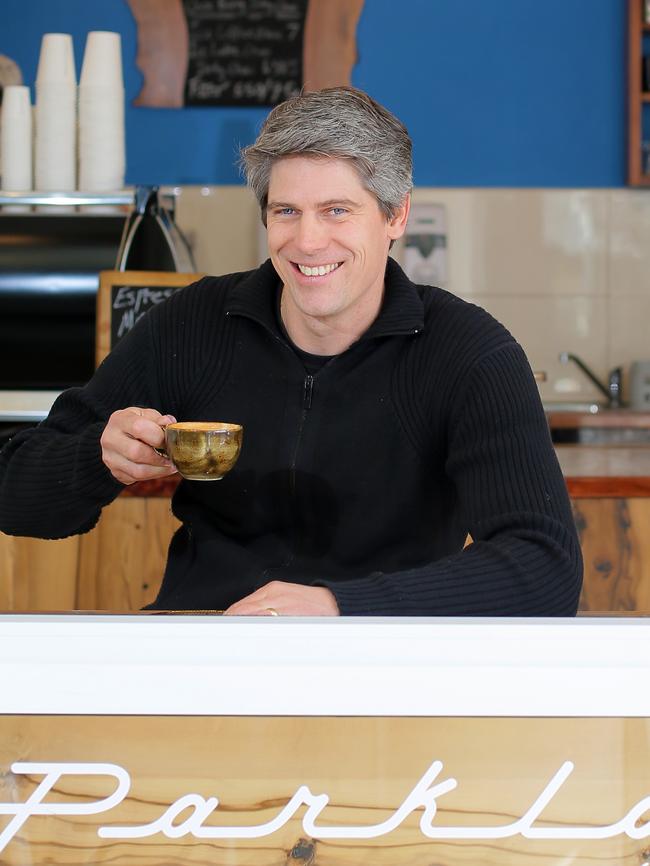
“It used to be maybe you would make some cappuccinos while you finish your degree, but what we’ve found now is working in coffee can be a career,” he says.
Kinesevic says ultimately every barista’s ambition is to own a cafe.
“They’ll work with someone as a mentor and that business owner has to know that one day they’ll generally want more,” he says.
“It’s not hard for a good personality and barista to start their own business. Someone will invest in them.”
Former chippie Joe Ware turned his wife Sarah’s former beauty salon in Salamanca Square into Parklane Espresso in mid-2013.
The tiny cafe has been voted by users of the Beanhunter smartphone app the best place for coffee in Hobart.
“We’re still growing and it’s great to see new faces coming in,” Ware says.
Now employing a handful of staff and with all profits remaining in local hands, Parklane is a tangible example of how the nation’s coffee addiction is fuelling an important new economy.
Priestley is proud of what he has achieved without completing a degree, although his ag science background comes in handy when working with coffee growers and milk producers.
“When I was at school the push was all about going to uni but now you look at tradies and sommeliers and high-end waiters and you don’t have to go to uni, you can have a really good life doing what makes you happy,” Priestley says.
“But having said that I do still work every day,” he says with a grin as he shoots back to the counter.
For more great lifestyle reads, pick up a copy of TasWeekend in today’s Saturday Mercury.


